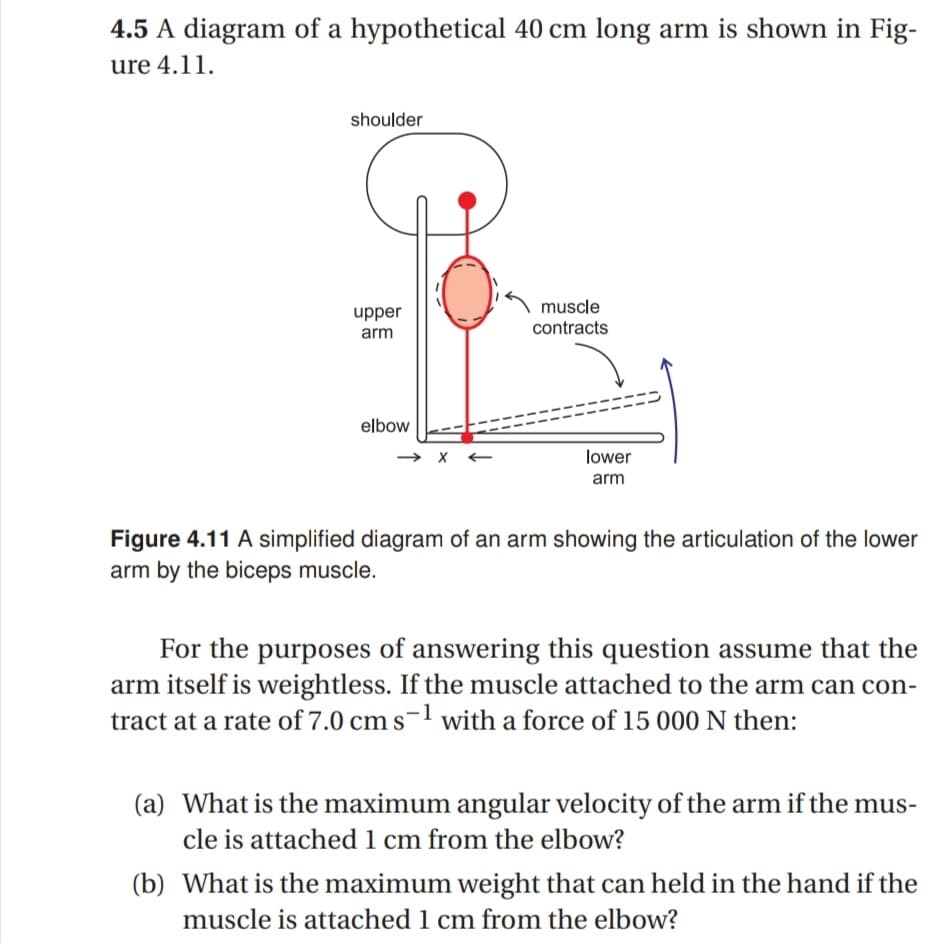4.5 A diagram of a hypothetical 40 cm long arm is shown in Fig- ure 4.11. shoulder upper arm muscle contracts elbow lower arm Figure 4.11 A simplified diagram of an arm showing the articulation of the lower arm by the biceps muscle. For the purposes of answering this question assume that the arm itself is weightless. If the muscle attached to the arm can con- tract at a rate of 7.0 cm s- with a force of 15 000 N then: (a) What is the maximum angular velocity of the arm if the mus- cle is attached 1 cm from the elbow? (b) What is the maximum weight that can held in the hand if the muscle is attached 1 cm from the elbow?
4.5 A diagram of a hypothetical 40 cm long arm is shown in Fig- ure 4.11. shoulder upper arm muscle contracts elbow lower arm Figure 4.11 A simplified diagram of an arm showing the articulation of the lower arm by the biceps muscle. For the purposes of answering this question assume that the arm itself is weightless. If the muscle attached to the arm can con- tract at a rate of 7.0 cm s- with a force of 15 000 N then: (a) What is the maximum angular velocity of the arm if the mus- cle is attached 1 cm from the elbow? (b) What is the maximum weight that can held in the hand if the muscle is attached 1 cm from the elbow?
Principles of Physics: A Calculus-Based Text
5th Edition
ISBN:9781133104261
Author:Raymond A. Serway, John W. Jewett
Publisher:Raymond A. Serway, John W. Jewett
Chapter4: The Laws Of Motion
Section: Chapter Questions
Problem 56P
Related questions
Topic Video
Question

Transcribed Image Text:4.5 A diagram of a hypothetical 40 cm long arm is shown in Fig-
ure 4.11.
shoulder
muscle
upper
arm
contracts
elbow
lower
arm
Figure 4.11 A simplified diagram of an arm showing the articulation of the lower
arm by the biceps muscle.
For the purposes of answering this question assume that the
arm itself is weightless. If the muscle attached to the arm can con-
tract at a rate of 7.0 cm s-1 with a force of 15 000 N then:
(a) What is the maximum angular velocity of the arm if the mus-
cle is attached 1 cm from the elbow?
(b) What is the maximum weight that can held in the hand if the
muscle is attached 1 cm from the elbow?
Expert Solution
This question has been solved!
Explore an expertly crafted, step-by-step solution for a thorough understanding of key concepts.
This is a popular solution!
Trending now
This is a popular solution!
Step by step
Solved in 2 steps

Knowledge Booster
Learn more about
Need a deep-dive on the concept behind this application? Look no further. Learn more about this topic, physics and related others by exploring similar questions and additional content below.Recommended textbooks for you

Principles of Physics: A Calculus-Based Text
Physics
ISBN:
9781133104261
Author:
Raymond A. Serway, John W. Jewett
Publisher:
Cengage Learning

College Physics
Physics
ISBN:
9781305952300
Author:
Raymond A. Serway, Chris Vuille
Publisher:
Cengage Learning

College Physics
Physics
ISBN:
9781938168000
Author:
Paul Peter Urone, Roger Hinrichs
Publisher:
OpenStax College

Principles of Physics: A Calculus-Based Text
Physics
ISBN:
9781133104261
Author:
Raymond A. Serway, John W. Jewett
Publisher:
Cengage Learning

College Physics
Physics
ISBN:
9781305952300
Author:
Raymond A. Serway, Chris Vuille
Publisher:
Cengage Learning

College Physics
Physics
ISBN:
9781938168000
Author:
Paul Peter Urone, Roger Hinrichs
Publisher:
OpenStax College

University Physics Volume 1
Physics
ISBN:
9781938168277
Author:
William Moebs, Samuel J. Ling, Jeff Sanny
Publisher:
OpenStax - Rice University

College Physics
Physics
ISBN:
9781285737027
Author:
Raymond A. Serway, Chris Vuille
Publisher:
Cengage Learning

Physics for Scientists and Engineers
Physics
ISBN:
9781337553278
Author:
Raymond A. Serway, John W. Jewett
Publisher:
Cengage Learning